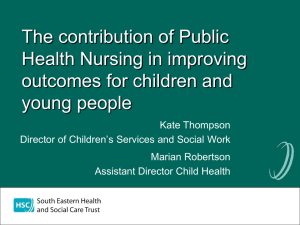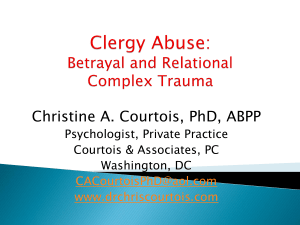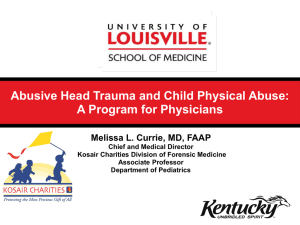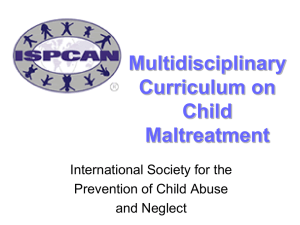Addressing Interpersonal Trauma and its Impact on Relationships
advertisement
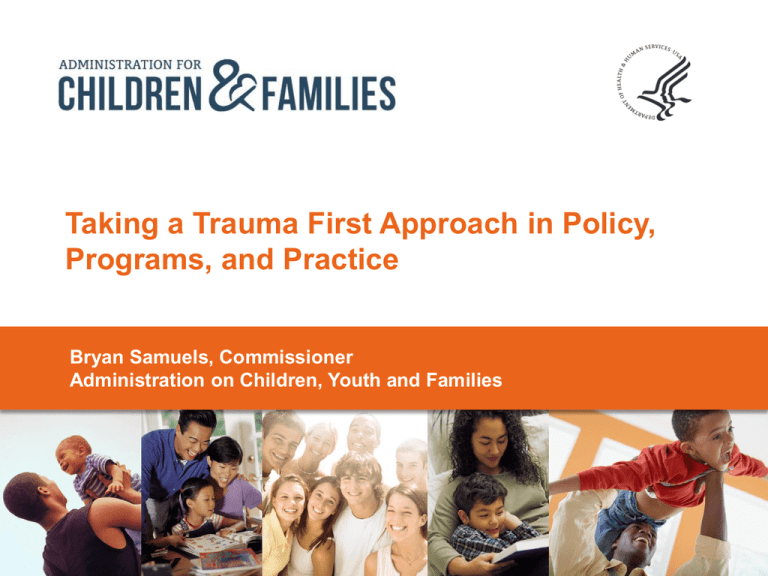
Taking a Trauma First Approach in Policy, Programs, and Practice Bryan Samuels, Commissioner Administration on Children, Youth and Families Interpersonal Trauma “[Complex trauma – also referred to as “developmental trauma disorder” or “chronic interpersonal trauma”] refers to children’s experiences of multiple traumatic events that occur within the caregiving system – the social environment that is supposed to be the source of safety and stability in a child’s life. Typically, complex trauma exposure refers to the simultaneous or sequential occurrences of child maltreatment—including emotional abuse and neglect, sexual abuse, physical abuse, and witnessing domestic violence—that are chronic and begin in early childhood. Moreover, the initial traumatic experiences (e.g., parental neglect and emotional abuse) and the resulting emotional dysregulation, loss of a safe base, loss of direction, and inability to detect or respond to danger cues, often lead to subsequent trauma exposure (e.g., physical and sexual abuse, or community violence).” Southerland, D; Casaneuva, CE; & Ringeisen, H. (2009). Young adult outcomes and mental health problems among transition age youth investigated for maltreatment during adolescence. Children and Youth Services Review. 31(9):947. September 21, 2012 ATTACh Conference 2 Impact of Trauma on Healthy Development September 21, 2012 Abusive or Neglectful Parenting Insecure Attachments, Emotional Dysregulation, Negative Internal Working Models Poor Social-Emotional Functioning, Disturbed/Negative Relationships Maladaptive Coping Strategies Psychological Distress Poor Adult Functioning/Outcomes ATTACh Conference 3 Maltreatment Impacts How Youth Form Relationships with Adults • Child maltreatment represents an extreme form of child–parent relationship disruption (Harden, 2004; Milan & Pinderhughes, 2000). • Child maltreatment can be defined as a chronic interpersonal trauma, to which the child is exposed on a daily basis(Perry, 2008; van der Kolk, 2005). • Children’s capacity to adequately cope with stress depends largely on the nature of the stress and on the attachment figure’s capacity to diminish or counter the effects (Lyons-Ruth et al., 1999). • The developmental stage of the child at the onset of the abuse and neglect will influence the type and severity of the consequences (Frederico, Jackson & Black 2005; Perry 1995). Apr. 2, 2012 Ntl. Forum on Youth Violence Prevention 4 Relational Functioning as Well-being? Correlates of Resilience to Adult Psychopathology Stable relationship history 53% Quality adult friendships 44% Supportive first intimate partner 40% 62% Caring relationship w/ either parent Normal peer relationships 53% Age at onset of abuse (<10 years) 25% Duration of abuse (>1 year) 20% Sexual or Severe Physical abuse 11% 0% 10% 20% 30% 40% 50% 60% 70% Collishaw, S; Pickles, A; Messer, J; Rutter, M; Shearer, C & Maughan, B. (2007). Resilience to adult psychopathology following childhood maltreatment: Evidence from a community sample. Child Abuse and Neglect. 31:211. Apr. 2, 2012 Ntl. Forum on Youth Violence Prevention 5 Relationships as Protective Factors ISLE OF WIGHT STUDY • Study showed child abuse is linked with difficulties in interpersonal relationships. • Adolescent psychiatric difficulties showed strong continuity of difficulties into adulthood. • However, 45% of abused individuals reported no mental health problems in adult life. • Half of those reporting abuse in adulthood had been rated as showing significant abnormalities in interactions with peers in adolescence. • At the same time, peer relationships in adolescence emerged as one of the strongest predictors of no mental health problems in adult life. • Some individuals in the abused resilient group showed evidence of isolated difficulties, but rates of difficulties were lower than for the rested of abused group. Collishaw, S; Pickles, A; Messer, J; Rutter, M; Shearer, C & Maughan, B. (2007). Resilience to adult psychopathology following childhood maltreatment: Evidence from a community sample. Child Abuse and Neglect. 31:211. 6 September 21, 2012 ATTACh Conference “DSM-IV psychiatric disorder connects with relationship functioning domains: high parental care; normal adolescent peer relationships; good adult friendships; supportive first partner, stable relationship history).” Rate of Adult Psychiatric Disorder 100% 90% Abuse 80% No Abuse 70% 60% 50% 40% 30% 20% 10% 0% 1 2 3 4 Number of Domains of Successful Relationship Functioning Collishaw, S; Pickles, A; Messer, J; Rutter, M; Shearer, C & Maughan, B. (2007). Resilience to adult psychopathology following childhood maltreatment: Evidence from a community sample. Child Abuse and Neglect. 31:211. September 21, 2012 ATTACh Conference 7 Relationships as Protective Factors ISLE OF WIGHT STUDY • Study supports view: – impairments in interpersonal relationships are of crucial importance for understanding the effects of child abuse on mental health outcomes. – positive relationships should not be seen as good fortune arising from chance encounters with a supportive friend, peer or partner, but rather as an ongoing process of developing the competencies necessary to form, maintain and benefit from supportive interpersonal relationships. – individuals with good relationship experiences across different domains and across childhood, adolescence and adulthood who were particularly likely to demonstrate healthy adult outcomes. – understanding the processes whereby relationship competencies are developed and maintained constitutes an important goal for future research and target for clinical interventions. September 21, 2012 ATTACh Conference 8 Older Youth Entry into Foster Care - 2011 84,518 out of 252,320 Entries are Adolescents 11 Years 8,118 9,141 12 Years 10,741 13 Years 13,132 14 Years 15,878 15 Years 16,288 16 Years 11,220 17 Years Data Source: Adoption and Foster Care Analysis and Reporting System (AFCARS), U.S. Department of Health and Human Services September 21, 2012 ATTACh Conference 9 “Simply removing a child from a dangerous environment will not by itself undo the serious consequences or reverse the negative impacts of early fear learning. There is no doubt that children in harm’s way should be removed from a dangerous situation. However, simply moving a child out of immediate danger does not in itself reverse or eliminate the way that he or she has learned to be fearful. The child’s memory retains those learned links, and such thoughts and memories are sufficient to elicit ongoing fear and make a child anxious.” National Scientific Council on the Developing Child (2010). Persistent Fear and Anxiety Can Affect Young Children’s Learning and Development: Working Paper No. 9. Retrieved fromwww.developingchild.harvard.edu December 9, 2011 ZERO TO THREE National Training Institute 10 Programmatic Elements of TraumaFirst Approach Addressing secondary trauma Build capacity to deliver EBPs; contract for externallydelivered EBPs Traumainformed screening and mental health assessment Knowledge building for staff and foster parents Developmentally specific approach September 21, 2012 TraumaFirst Child Welfare Approach ATTACh Conference Cross-system partnerships and collaboration 11 Practice Elements of Trauma-First Approach Promotion of healthy relationships Monitor progress for reduced symptoms and improved child/youth functioning Focusing on child- and family-level outcomes (as opposed to process outcomes alone) September 21, 2012 Proactive approach to addressing social and emotional needs TraumaFirst Child Welfare Approach ATTACh Conference Trauma-informed case planning and management 12 Multi-Level Strategy to Address Trauma and Promote Well-Being Policy Program Practice Promoting Safe and Stable Families – Trauma Screening and Treatment FOA: Screening, Assessment, and Services Array Permanency Innovations Initiative – Illinois Information Memoranda: Well-Being, Psychotropics, CQI FOA: Regional Partnership Grants Collaboration with SAMHSA IM: Title IV-E Child Welfare Waiver Demonstration Projects Protective Factors across Populations Waiver Demonstrations in 6 States CMS: Early and Periodic Screening, Diagnosis, and Treatment Ending Youth Homelessness (USICH) FOA: Integrating Trauma into Child Welfare Services Workforce USAID FOA: Supportive Housing and Child Welfare Neuroscience and Child Maltreatment September 21, 2012 ATTACh Conference 13 Feeling safe and stable in the living environment Able to manage emotions and regain equilibrium when upset Belonging and social connectedness (permanency) WELLBEING Able to sustain positive interpersonal relationships Self-efficacy based on developing competencies Adapted from Impact Youth Services, 2011; http://impactyouthservices.com/goals.htm Has a positive self image September 21, 2012 A More Complete Picture of WellBeing ACYF-CB-IM-12-04: http://www.acf.hhs.gov/programs/cb/laws_p olicies/policy/im/2012/im1204.pdf ATTACh Conference 14






